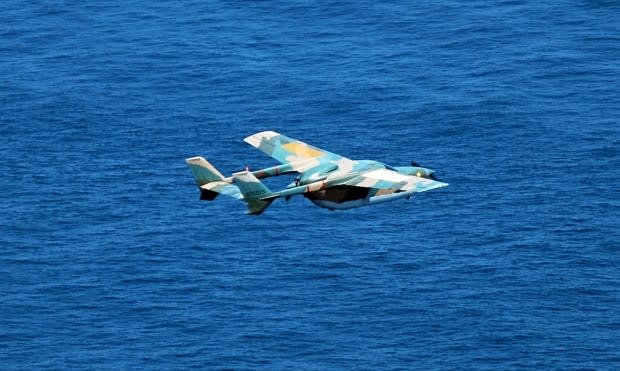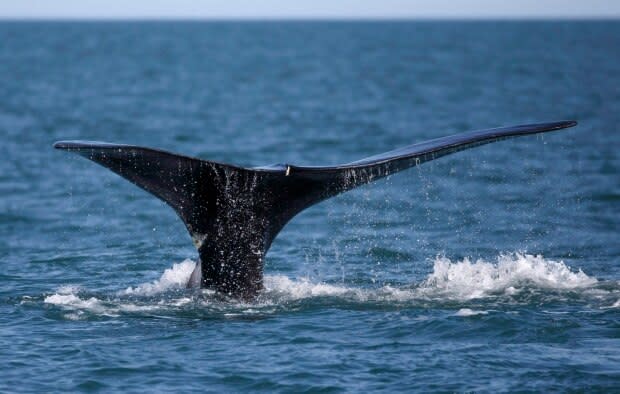How spotting right whales from space could help save them
The key to saving endangered North Atlantic right whales could come from space, says a Nova Scotia researcher who's developing technology that would scan satellite imagery and relay the whereabouts of the elusive mammals within hours.
It's one of the best hopes for keeping up with the whales that are fast and hard to detect, said Olivia Pisano, a PhD student in marine biology at Dalhousie University in Halifax.
"Because they can move so quickly, you can make a decision about one part of the [Gulf of St. Lawrence] and then have them show up in another part of the Gulf the next day, and so you're constantly playing this game of catch up," she told CBC's Information Morning.
"When it comes to right whales, we need to start being more proactive."
Satellites orbiting Earth have views of the Atlantic Ocean and Gulf of St. Lawrence and can scan large swaths of the whales' habitat in a relatively short period of time, Pisano said.
She said while satellites have been used to track animals in polar regions, they've yet to be recruited in the fight to save North Atlantic right whales, whose population has dwindled to about 400.
The team at Dalhousie is developing a computer algorithm that would process the satellite imagery, as well as aerial imagery, and determine how many right whales are in the area.

This "machine-learning algorithm" can do the work far quicker than a human can, which saves valuable time, Pisano said.
"If we were to know within hours that there was a whale spotted in a certain area, then we can notify the right people and we can start to get some management protections going," she said.
Last year, 10 right whales were found dead in Canadian and United States waters, and there has been one death so far this year. A six-month-old calf was found dead earlier this summer with wounds that appeared consistent with a ship strike.
Ship strikes and entanglements are often to blame for right whale deaths, leading governments to introduce measures, such as speed restrictions and fishery closures.
At the beginning of August, Transport Canada imposed new temporary restrictions in a part of the Gulf of St. Lawrence near the Shediac Valley where right whales are known to be.
Vessels larger than 13 metres aren't allowed in the zone, although there are exemptions for activities such as commercial and Indigenous fishing, as well as research and enforcement. These vessels must slow down to below eight knots in the restricted area.

Right now, researchers keep track of the whales using a number of methods, including survey Jlans, acoustic monitoring and gliders, and Pisano hopes satellite imagery can be another tool governments and conservationists use.
It's an area of research that's largely been untapped when it comes to right whales in northern waters, she said.
"This is a relatively new technology," Pisano said. "This is really not something that's been done before or tried before, so this is all new to us, but we really do feel that it will give us an advantage in protecting the whales."
Dalhousie researchers began working on the project in January 2019, and Pisano believes the team could have a preliminary tool ready by sometime next year.
Challenges with the technology
Sean Brillant, senior conservation biologist with the Canadian Wildlife Federation, said this area of research is both promising and needed, given how hard it is to track the whales.
But he also sees a number of challenges with the new frontier of satellite imagery, which will likely take years to fully develop.
One problem is that right whales usually spend less than 20 per cent of their time on the surface of the water, Brillant said.

"Satellites, they're only covering parts of the ocean [for] certain periods of time, so we don't have 24-hour coverage in all parts of the ocean," he said. "If conditions aren't right, so if there is a lot of cloud cover, if there is a lot of shine off the ocean … then it's not suitable to look on the water."
He said saving right whales will require "an accumulation of all these detection technologies," along with people being more responsible about how they use the ocean.
Brillant is encouraged that there's only been one confirmed right whale death reported in the U.S. this year so far, but he doesn't want Canadians to become complacent.
"It feels like it's been a lucky year and we need to be prepared to make further tough decisions ... about how to manage our activities on the ocean," he said.
MORE TOP STORIES


